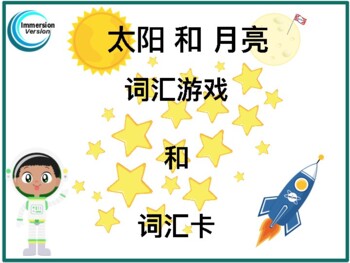Chinese_Sun & Moon: Vocabulary Games and Word Wall Cards
ImmersionVersion
45 Followers
Grade Levels
K - 3rd
Subjects
Resource Type
Standards
NGSS1-ESS1-1
NGSS1-ESS1-2
Formats Included
- PDF
- Easel Activity
ImmersionVersion
45 Followers
Easel Activity Included
This resource includes a ready-to-use interactive activity students can complete on any device. Easel by TPT is free to use! Learn more.
Also included in
- Grab the bundle of vocabulary games and word walls cards in Chinese for the following science units:Light and ShadowsSun and MoonNatural ResourcesPlants and their EnvironmentsThese 4 units include games such as Who am I?, Go Fish, 4 Corners, Hot Potato, Clip It, Bingo, board games, and more. StudentPrice $14.40Original Price $18.00Save $3.60
Description
This resource was created for Chinese Immersion Students.
Prepare immersion (or ELL) students for the sun and moon science unit with these vocabulary games and word wall cards. These games are great for morning meetings, brain breaks, and center activities. Introduce these games prior to the start of the new unit, and your students will have a foundation set to explore these concepts.
Games included are:
-4 Corners
-Hot Potato
-Go Fish
-Bingo
-Who am I?
-Clip Cards
-Board Game
Thank you to Mei Hung Lo for the the translations.
Total Pages
Answer Key
N/A
Teaching Duration
N/A
Last updated Nov 30th, 2020
Report this resource to TPT
Reported resources will be reviewed by our team. Report this resource to let us know if this resource violates TPT’s content guidelines.
Standards
to see state-specific standards (only available in the US).
NGSS1-ESS1-1
Use observations of the sun, moon, and stars to describe patterns that can be predicted. Examples of patterns could include that the sun and moon appear to rise in one part of the sky, move across the sky, and set; and stars other than our sun are visible at night but not during the day. Assessment of star patterns is limited to stars being seen at night and not during the day.
NGSS1-ESS1-2
Make observations at different times of year to relate the amount of daylight to the time of year. Emphasis is on relative comparisons of the amount of daylight in the winter to the amount in the spring or fall. Assessment is limited to relative amounts of daylight, not quantifying the hours or time of daylight.







